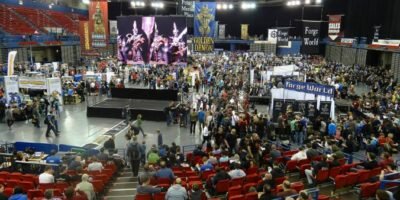Mantic Games are now running a Kickstarter for their Sci-Fi Miniatures Board Game Deadzone.
Deadzone is Mantic Games’ fourth game on Kickstarter and, judging by its popularity so far, their most successful one yet. Like the fantastic DreadBall (which I hope to play next week at Mantic’s Open Day), Deadzone was designed – or better, is being designed – by veteran game designer Jake Thornton. Despite his busy schedule (drafting the Deadzone rules, updating the Kickstarter, his designer Journal over on Quirkworthy, etc… ), Jake sacrificed some of the few hours he normally reserves for sleeping to answer my questions about Deadzone.
This Deadzone interview covers the following
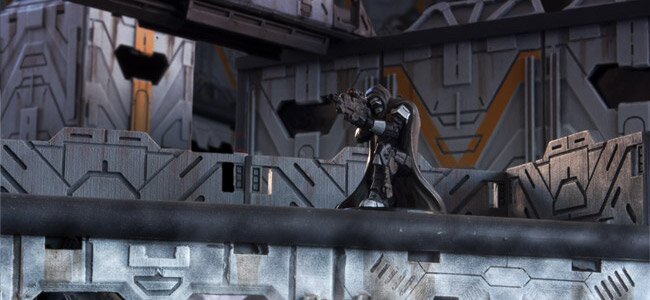
Mantic Games’ Deadzone
#1 – The Idea Behind Deadzone
Zweischneid: Hi Jake. Many thanks for this interview! Deadzone, the latest game you designed, is now on Kickstarter. It funded in less than an hour and is racing towards US$ 350.000,-.
I think neither you, nor Deadzone at this point, will need a basic introduction.
Instead, I would love to hear how you – as a veteran designer of many great miniature games – got started making Deadzone!
What was your main goal? What type of game did you want to make, and for whom?
Jake: Deadzone was an idea that I’d been talking to Ronnie at Mantic about for a while.
He was very keen to make some really cool new modular terrain that would allow people to construct all sorts of different buildings. I naturally saw that simply as an unusual environment in which to play an interesting game.
My original mental picture of the game was as a clash between a pair of elite forces, meeting in the favelas or shanties where a mix of narrow alleys and low roofs made the battlefield very three-dimensional. As often happens, my mental image is a little impractical for games and suits movies better, but, as is also common, I found I could still bring that feeling and atmosphere to the tabletop. Deadzone retains that sense of claustrophobia and desperation: the play area is deliberately small and cramped with nowhere to hide for long.
In many ways I just design games for myself! During playtesting I will play a game many dozens of times and so if I don’t like it then that’s a hard job. What I like is relatively simple rules that generate a great many tactical challenges and decision points within the game itself. I want to play a game and think about what’s going on and what I’m going to do next, not struggle with how the rules work. I prefer games to be quick to play and pause only for the players to think, not to look up rules, and to keep everyone involved as much as possible.
If that sounds like a set of good ideas to you, then maybe I designed the game for you too
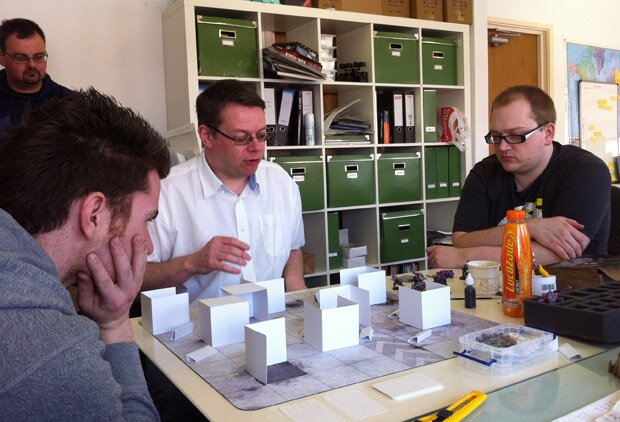
Deadzone games are designed to be claustrophobic with tight, twisting alleyways. In this picture, Jake Thornton (middle) takes Mantic Games’ Josh Roberts and James M. Hewitt through a pre-alpha version of the game. Note that the gaming mat is a prototype.
#2 – Deadzone Game-Play: Dice and Movement
Zweischneid: Let’s talk about some of the game-play details.
Deadzone uses eight-sided dice (D8). That, certainly, was a bit of a surprise to me! DreadBall – which you designed as well – uses six-sided dice (D6). In a brief interview you gave Beasts of War at Salute 2013, you even mentioned Deadzone adopts a few game mechanics from DreadBall.
Why the D8 in Deadzone? What does it add to the game? How does it affect the game-play?
Jake: After a couple of early experiments that used D6s and D10s, we decided to reuse the core dice mechanic from DreadBall. This had proved to be a simple and popular system and it would also give the game a familiar “house style” element.
However, the kind of game that Deadzone needed to be was always going to include more variety than DreadBall, with more choice of troop types than players, far more missions and a variable playing area in three dimensions instead of two.
The simplest way to get the range of options we needed to be able to differentiate this number of variables was to pick a dice with more sides. It was a bit like Goldilocks and the porridge: six was too few, 10 was more than we needed. Eight felt just right.
In most instances, the D8 works just the same as the D6 does in DreadBall.
However, we also have the useful addition of being able to use it to resolve scattering grenades (as we work on a square grid), or to randomise positions on the board (as the whole board is eight squares by eight squares).
Zweischneid: Deadzone is curious hybrid of a game. Though it is a tabletop skirmish game, it has many board-game elements. Most notably, Deadzone is played on a grid-based gaming map to determine things such as movement, cover or weapon-ranges. It also uses a card-based system.
Jake: It does indeed. I thought that it would give me a better game if I took the best bits of each format and rolled them together rather than restricting myself to one source. I’m also pinching a couple of concepts from video games.
Zweischneid: Can you give a hint at how movement will work? Will a player move entire units, or individual models? Is movement governed by an action/activation system similar to DreadBall’s Action Tokens?
Jake: All movement is by individual model. Each model can make one long or two short actions per turn, and a move action is a short action that moves the model one square.
The Alpha rule set has a modified i-go-u-go turn sequence with interrupts and overwatch, but this does not scale as well as I would like to larger battles. The turn sequence currently being tested is a modified alternate action system that has several advantages whilst retaining the speed of play and the ability to make co-ordinated actions.
#3 – Deadzone Game-Play: The Card Deck
Zweischneid: Can you share some insights on the Deadzone cards? In the Kickstarter-video the cards appear straightforward enough, showing 5 traits for each miniature and a few “icons”. These cards will be combined with equipment cards?
There is also a reference to “building aggression”? I would certainly love to hear a bit more on that!
Jake: Each faction has its own deck of cards, and these cards come in three types: stat cards, mission cards and a battle deck.
Stat cards list the game values for each type of model available to that faction. Mission cards each describe the victory conditions for a different mission. The battle deck is used during the game to give models extra actions and boosts for individual tests, among other things.
Aggression is a way of tracking a model’s morale and level of aggression all in one simple status.
Most models start the game Alert. This means that they are up and about, doing their job as expected. If they are shot at they may become Pinned. This stops them doing anything except hiding, but is easily shaken off. They may get even worse than this and become Suppressed, which takes longer to remove. At the other end, they can become Enraged, which makes them more dangerous in melee but also makes them less good at accurate shooting. Finally, if they completely lose control, they can go Berserk!
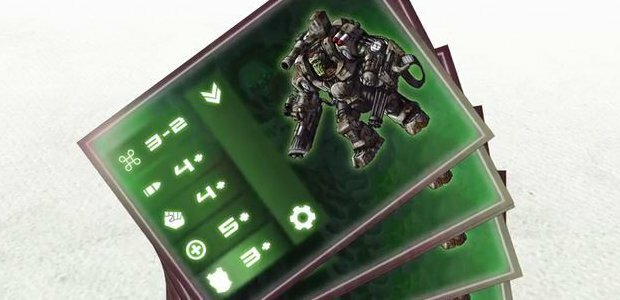
Concepts for Deadzone Cards for the Marauder Faction
#4 – The Deadzone Factions
Zweischneid: In Deadzone, very different factions face-off in battle – such as the disciplined, well equipped Enforcers against the heavily mutated victims of the Plague, many of which wield no weapons at all.
Jake: That’s right. There are 4 factions to start with, and if the Kickstarter goes well we would like to add more.
Zweischneid: How will commanding the Enforcers be different from playing the Plague? How do you – as designer – create different “styles” of play in Deadzone while ensuring they also remain balanced?
Jake: Balance is always an issue in any game where the sides are different.
There are a number of balancing factors used here. Firstly you choose an army to a fixed value and each type of model is worth a number of points. Powerful models cost more than weak ones.
Other factors are perhaps more subtle. One of the more important balancing factors is the set of missions available to each faction. In Deadzone, you win the game by collecting a given number of victory points before your opponent, and these are listed on the mission cards. What you get victory points for varies from mission to mission, and each faction has a different mix of mission cards. The Rebels, for example, are often interested in collecting loot from the battlefield, rather than just killing the enemy. They have bigger political issues to deal with and their efforts in the Deadzone are aimed at recovering supplies.
The style of a force depends on a variety of factors. Missions are one factor, the available troops are another as is the unique composition of each faction’s battle deck. Added together, this makes for a very different play experience for each side.
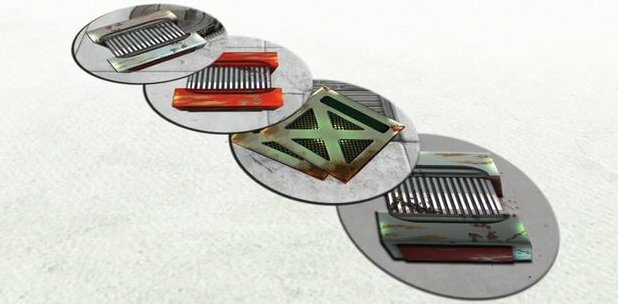
Loot counters for Deadzone: Contagion
#5 – Campaigns and Gainging Experience
Zweischneid: You mentioned different missions and objectives for the factions. The Kickstarter also mentions campaign play as a key feature of Deadzone. What kind of campaigns do you have in mind? What tools will there be for players link their individual games and build a campaign?
Jake: I’m working on two different types of campaign for Deadzone.
The first is an open-ended and fairly free form type that will allow people to play in their local club or with a group of friends. Models will gain experience and improve in various ways over the course of the battles, and the whole force will get access to new troop types and extra equipment.
The second campaign type is narrative based. This is based on a historical campaign and can either be played with the forces that took part or with your own army, progressing through the battles in the same sequence and with the same challenges as the original combatants. The experience and available equipment will be tailored to suit the specific story behind the campaign and so will be different from the free-form style.
Both these types of campaign are fun and so both are worth exploring.
Zweischneid: Another key feature of Deadzone – beyond fast-paced individual games – will be player progression and experience. I assume this applies to all factions? It seems straight-forward for most factions, yet it puzzles me for the Plague. How will this work in a campaign over several games? Will the “same” two forces clash again and again? Will Plague creatures grow smarter, more experienced?
Jake: Yes, and more mutated.
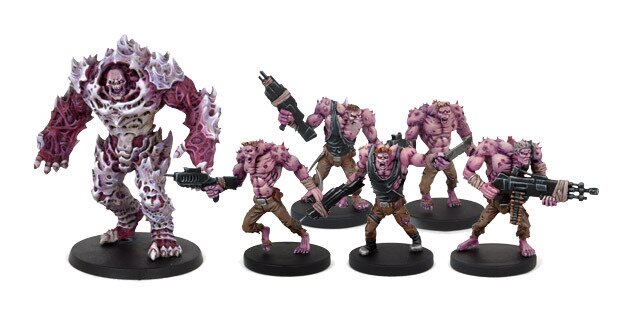
The Plague in Deadzone: Contagion
#6 – The Future of Deadzone
Zweischneid: So… expansions?!
Deadzone raised a quarter of a million US$ on the first weekend on Kickstarter! Obviously, there is massive potential there to add more miniatures, new faction, more terrain, and more during the course of this Kickstarter.
Nevertheless, with a massive success like this on your hands, do you have more ideas in your drawer on how the game itself might be expanded? What would you want to do with Deadzone, Kickstarter permitting, to take the game even further?
Jake: Well I’d like to have the time to explore the possibilities for the two types of campaign I’ve mentioned, more factions, solo play, multi-player games, and games on larger playing areas. I’m sure I’ll think of more. All seem to offer interesting alternative ways to explore and expand on the basic idea for the game and would give the gamer a great deal of play value from the set – something I’m always keen to include.
Zweischneid: Many, many thanks for the interview, Jake! I’ll certainly follow the Deadzone Kickstarter closely.
Jake: Thanks.
Again, many thanks to Jake for taking the time to answer my questions.
Deadzone is growing a huge fan-following and steaming away on Kickstarter. It’s about to break another Stretch-Goal for a free Goblin Marksman (!) as I get ready to publish this interview.
Make sure you have a look at the Kickstarter, Jake’s game-designer journal over at Quirkworthy.com, and to leave a comment below to let me know what you think!


